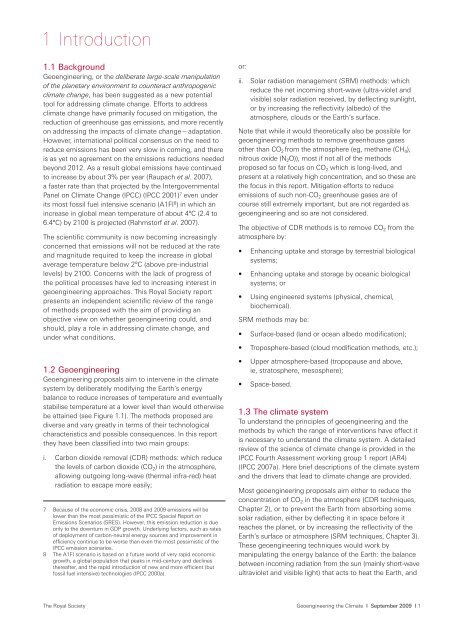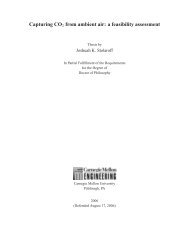Royal Society - David Keith
Royal Society - David Keith
Royal Society - David Keith
Create successful ePaper yourself
Turn your PDF publications into a flip-book with our unique Google optimized e-Paper software.
1<br />
Introduction<br />
1.1 Background<br />
Geoengineering, or the deliberate large-scale manipulation<br />
of the planetary environment to counteract anthropogenic<br />
climate change, has been suggested as a new potential<br />
tool for addressing climate change. Efforts to address<br />
climate change have primarily focused on mitigation, the<br />
reduction of greenhouse gas emissions, and more recently<br />
on addressing the impacts of climate change—adaptation.<br />
However, international political consensus on the need to<br />
reduce emissions has been very slow in coming, and there<br />
is as yet no agreement on the emissions reductions needed<br />
beyond 2012. As a result global emissions have continued<br />
to increase by about 3% per year (Raupach et al. 2007),<br />
a faster rate than that projected by the Intergovernmental<br />
Panel on Climate Change (IPCC) (IPCC 2001) 7 even under<br />
its most fossil fuel intensive scenario (A1FI 8 ) in which an<br />
increase in global mean temperature of about 4°C (2.4 to<br />
6.4°C) by 2100 is projected (Rahmstorf et al. 2007).<br />
The scientific community is now becoming increasingly<br />
concerned that emissions will not be reduced at the rate<br />
and magnitude required to keep the increase in global<br />
average temperature below 2°C (above pre-industrial<br />
levels) by 2100. Concerns with the lack of progress of<br />
the political processes have led to increasing interest in<br />
geoengineering approaches. This <strong>Royal</strong> <strong>Society</strong> report<br />
presents an independent scientific review of the range<br />
of methods proposed with the aim of providing an<br />
objective view on whether geoengineering could, and<br />
should, play a role in addressing climate change, and<br />
under what conditions.<br />
1.2 Geoengineering<br />
Geoengineering proposals aim to intervene in the climate<br />
system by deliberately modifying the Earth’s energy<br />
balance to reduce increases of temperature and eventually<br />
stabilise temperature at a lower level than would otherwise<br />
be attained (see Figure 1.1). The methods proposed are<br />
diverse and vary greatly in terms of their technological<br />
characteristics and possible consequences. In this report<br />
they have been classified into two main groups:<br />
i. Carbon dioxide removal (CDR) methods: which reduce<br />
the levels of carbon dioxide (CO 2 ) in the atmosphere,<br />
allowing outgoing long-wave (thermal infra-red) heat<br />
radiation to escape more easily;<br />
7 Because of the economic crisis, 2008 and 2009 emissions will be<br />
lower than the most pessimistic of the IPCC Special Report on<br />
Emissions Scenarios (SRES). However, this emission reduction is due<br />
only to the downturn in GDP growth. Underlying factors, such as rates<br />
of deployment of carbon-neutral energy sources and improvement in<br />
efficiency continue to be worse than even the most pessimistic of the<br />
IPCC emission scenarios.<br />
8 The A1FI scenario is based on a future world of very rapid economic<br />
growth, a global population that peaks in mid-century and declines<br />
thereafter, and the rapid introduction of new and more efficient (but<br />
fossil fuel intensive) technologies (IPCC 2000a).<br />
or:<br />
ii. Solar radiation management (SRM) methods: which<br />
reduce the net incoming short-wave (ultra-violet and<br />
visible) solar radiation received, by deflecting sunlight,<br />
or by increasing the reflectivity (albedo) of the<br />
atmosphere, clouds or the Earth’s surface.<br />
Note that while it would theoretically also be possible for<br />
geoengineering methods to remove greenhouse gases<br />
other than CO 2 from the atmosphere (eg, methane (CH 4 ),<br />
nitrous oxide (N 2 O)), most if not all of the methods<br />
proposed so far focus on CO 2 which is long-lived, and<br />
present at a relatively high concentration, and so these are<br />
the focus in this report. Mitigation efforts to reduce<br />
emissions of such non-CO 2 greenhouse gases are of<br />
course still extremely important, but are not regarded as<br />
geoengineering and so are not considered.<br />
The objective of CDR methods is to remove CO 2 from the<br />
atmosphere by:<br />
• Enhancing uptake and storage by terrestrial biological<br />
systems;<br />
• Enhancing uptake and storage by oceanic biological<br />
systems; or<br />
• Using engineered systems (physical, chemical,<br />
biochemical).<br />
SRM methods may be:<br />
• Surface-based (land or ocean albedo modification);<br />
• Troposphere-based (cloud modification methods, etc.);<br />
• Upper atmosphere-based (tropopause and above,<br />
ie, stratosphere, mesosphere);<br />
• Space-based.<br />
1.3 The climate system<br />
To understand the principles of geoengineering and the<br />
methods by which the range of interventions have effect it<br />
is necessary to understand the climate system. A detailed<br />
review of the science of climate change is provided in the<br />
IPCC Fourth Assessment working group 1 report (AR4)<br />
(IPCC 2007a). Here brief descriptions of the climate system<br />
and the drivers that lead to climate change are provided.<br />
Most geoengineering proposals aim either to reduce the<br />
concentration of CO 2 in the atmosphere (CDR techniques,<br />
Chapter 2), or to prevent the Earth from absorbing some<br />
solar radiation, either by deflecting it in space before it<br />
reaches the planet, or by increasing the reflectivity of the<br />
Earth’s surface or atmosphere (SRM techniques, Chapter 3).<br />
These geoengineering techniques would work by<br />
manipulating the energy balance of the Earth: the balance<br />
between incoming radiation from the sun (mainly short-wave<br />
ultraviolet and visible light) that acts to heat the Earth, and<br />
The <strong>Royal</strong> <strong>Society</strong><br />
Geoengineering the Climate I September 2009 I 1








